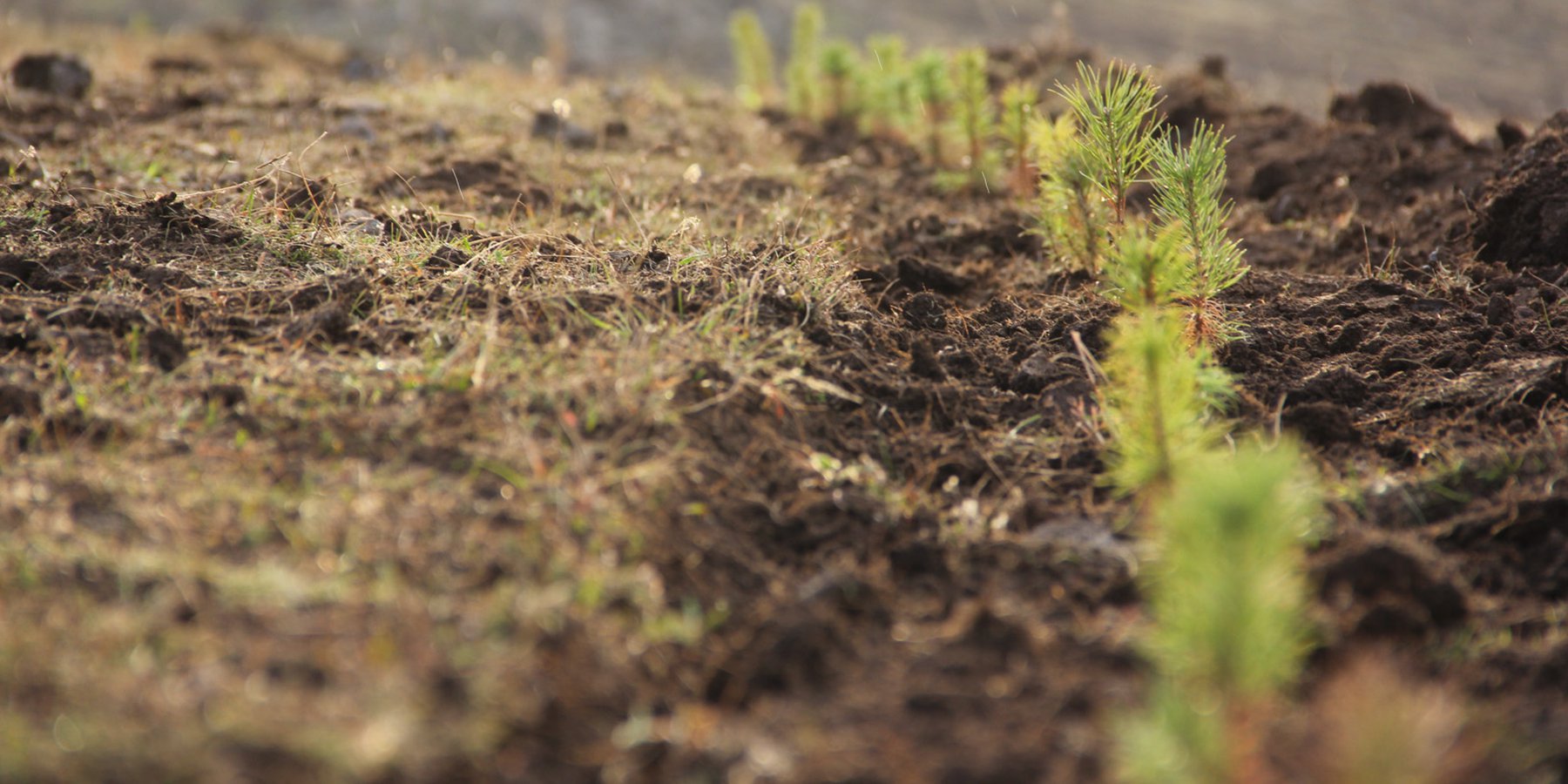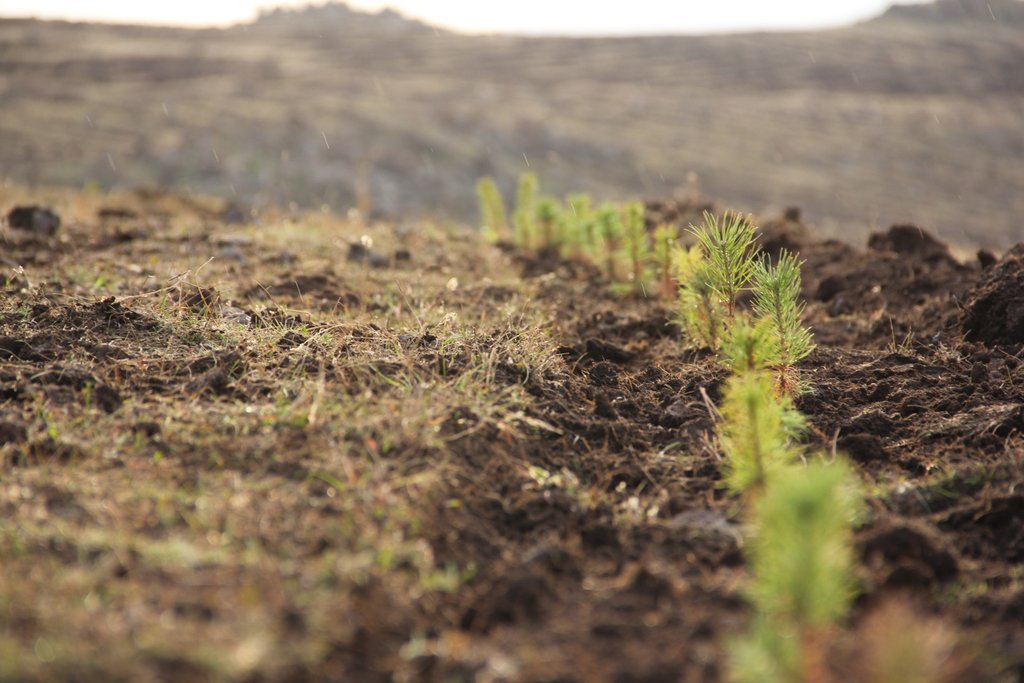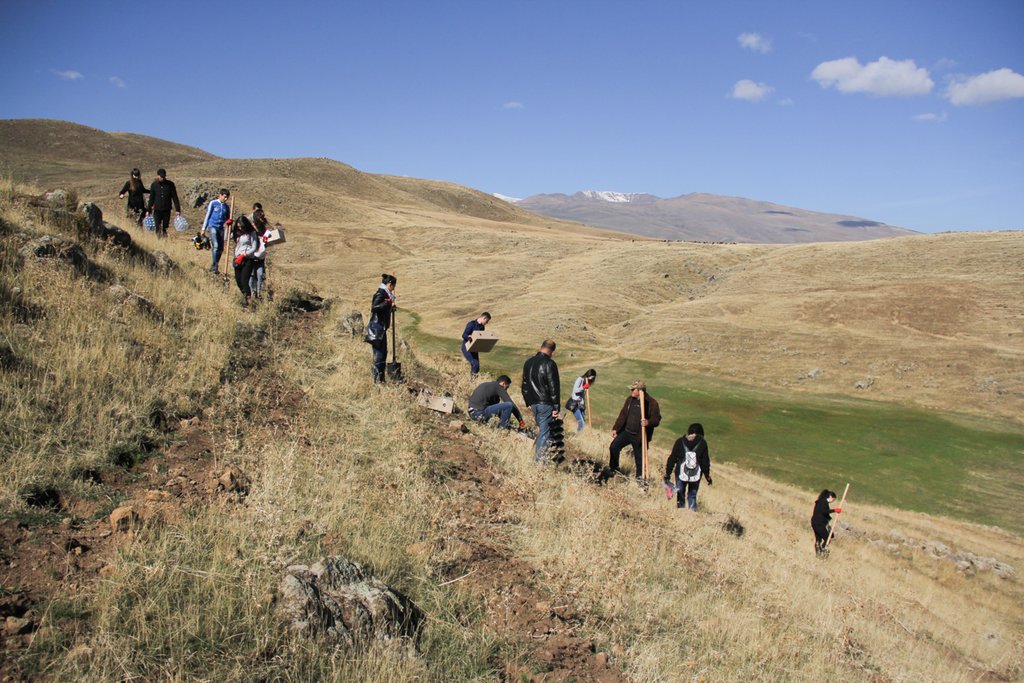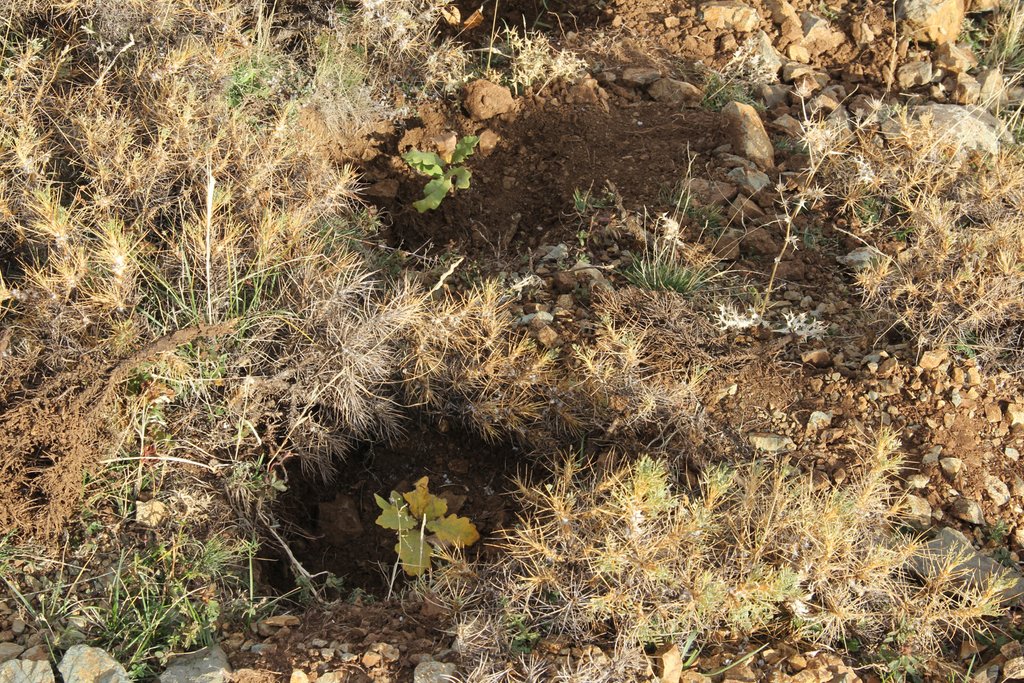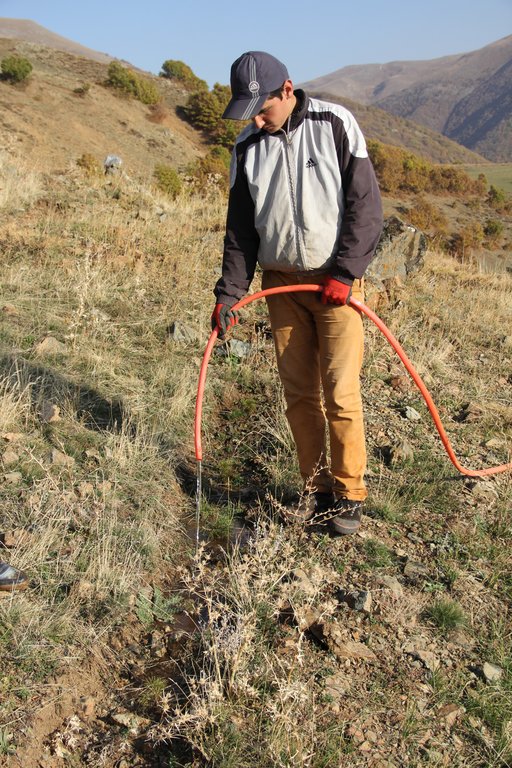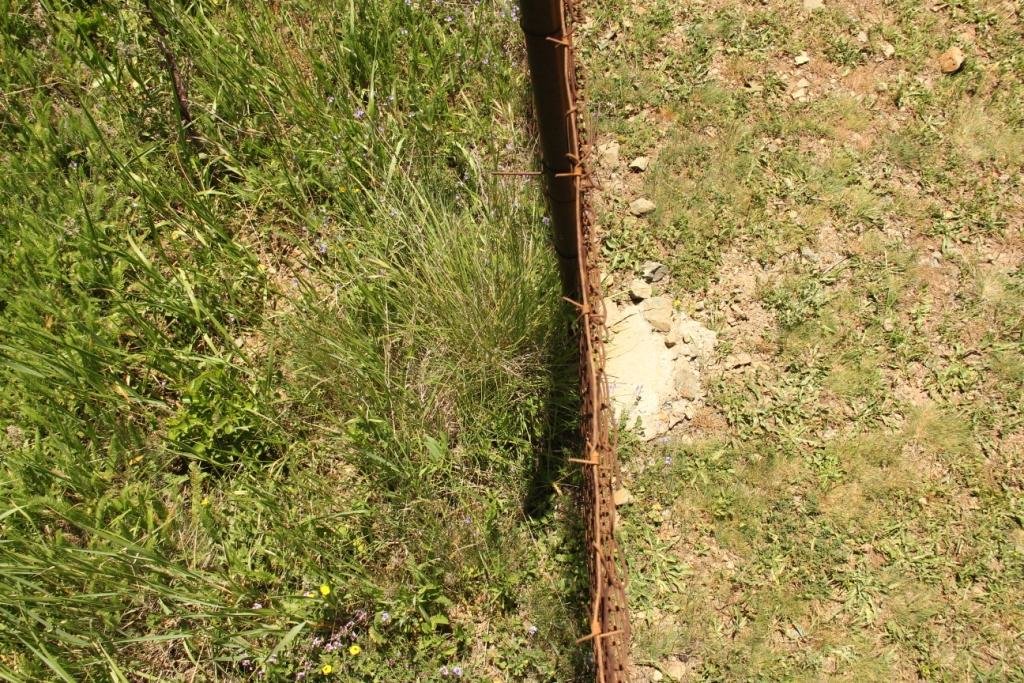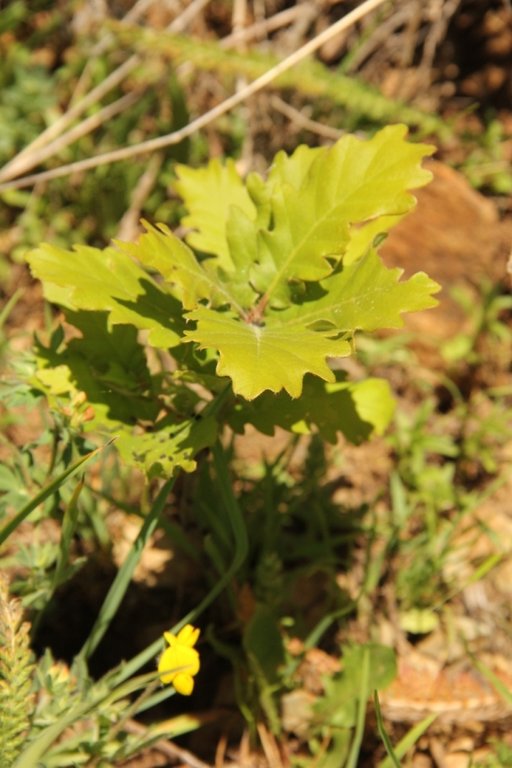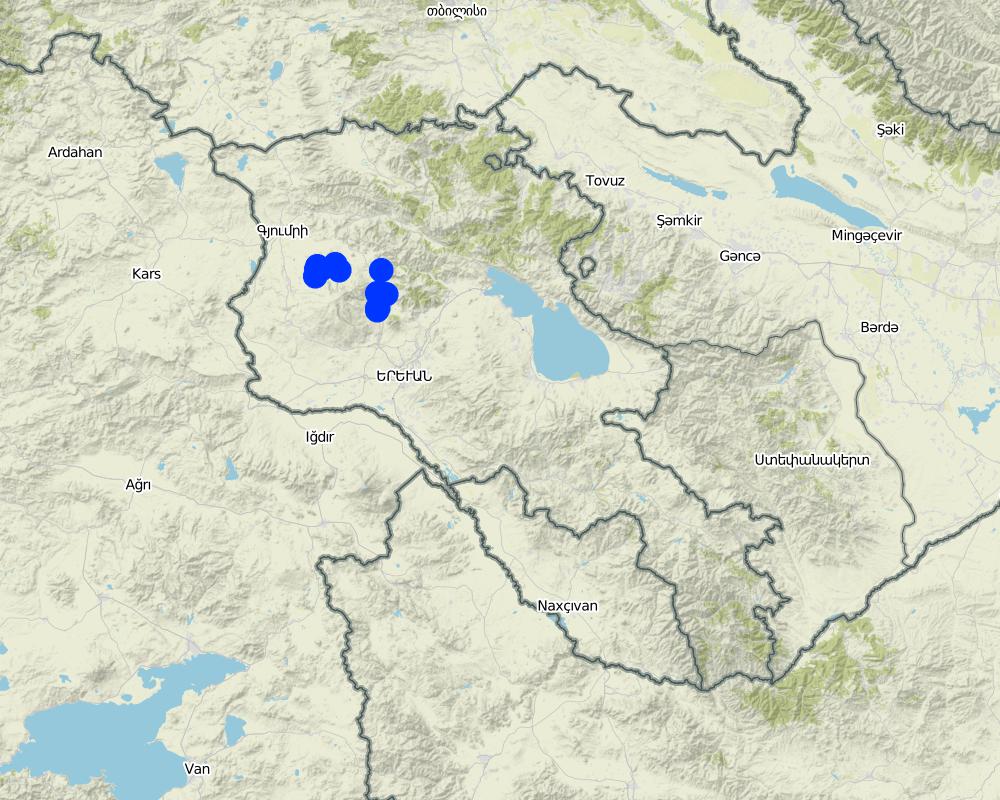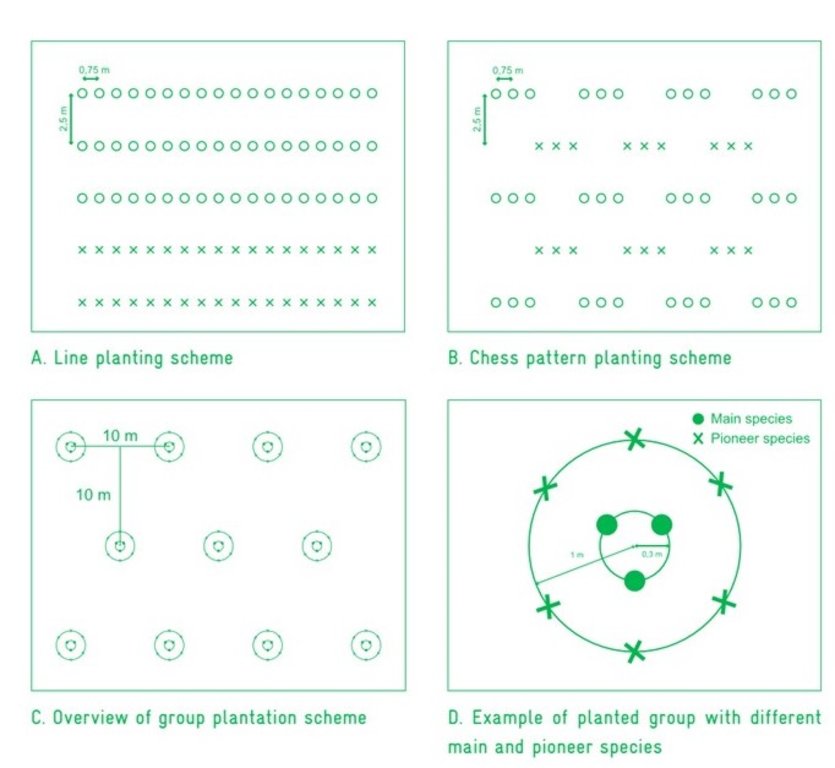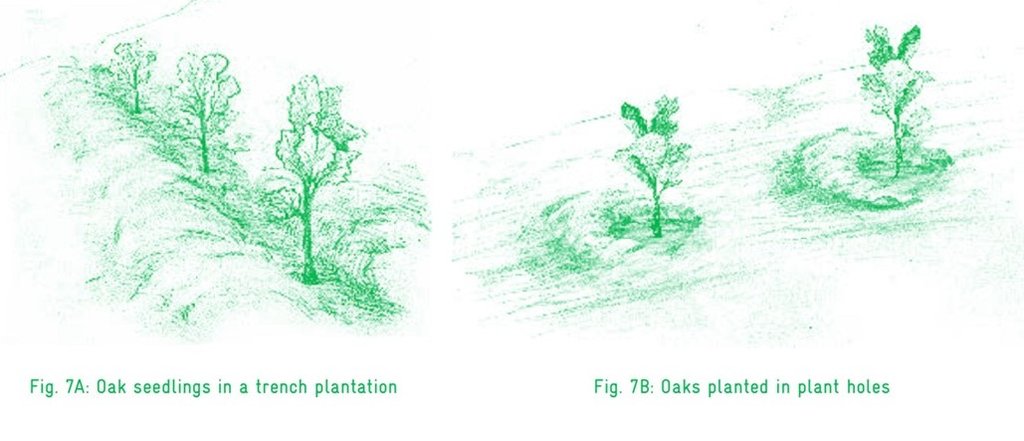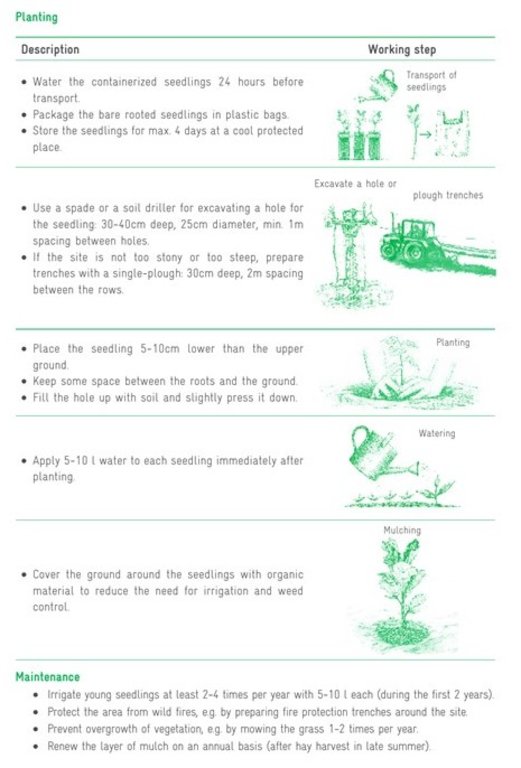High-altitude afforestation for erosion control [ອໍເມເນຍ]
- ການສ້າງ:
- ປັບປູງ:
- ຜູ້ສັງລວມຂໍ້ມູນ: Hanns Kirchmeir
- ບັນນາທິການ: Artur Hayrapetyan
- ຜູ້ທົບທວນຄືນ: Ursula Gaemperli
technologies_4101 - ອໍເມເນຍ
ເບິ່ງພາກສ່ວນ
ຂະຫຍາຍທັງໝົດ ຍຸບທັງໝົດ1. ຂໍ້ມູນທົ່ວໄປ
1.2 ຂໍ້ມູນ ການຕິດຕໍ່ພົວພັນ ຂອງບຸກຄົນທີ່ສໍາຄັນ ແລະ ສະຖາບັນ ທີ່ມີສ່ວນຮ່ວມ ໃນການປະເມີນເອກກະສານ ເຕັກໂນໂລຢີ
ຜຸ້ຊ່ຽວຊານ ດ້ານການຄຸ້ມຄອງ ທີ່ດິນແບບຍືນຍົງ:
ຊື່ໂຄງການ ທີ່ອໍານວຍຄວາມສະດວກ ໃນການສ້າງເອກກະສານ/ປະເມີນ ເຕັກໂນໂລຢີ (ຖ້າກ່ຽວຂ້ອງ)
Integrated Biodiversity Management, South Caucasus (IBiS)ຊື່ສະຖາບັນ (ຫຼາຍສະຖາບັນ) ທີ່ອໍານວຍຄວາມສະດວກ ໃນການສ້າງເອກກະສານ / ປະເມີນ ເຕັກໂນໂລຢີ (ຖ້າກ່ຽວຂ້ອງ)
Deutsche Gesellschaft für Internationale Zusammenarbeit (GIZ)1.3 ເງື່ອນໄຂ ກ່ຽວກັບ ການນໍາໃຊ້ຂໍ້ມູນເອກະສານ ທີ່ສ້າງຂື້ນ ໂດຍຜ່ານ ອົງການພາບລວມຂອງໂລກ ທາງດ້ານແນວທາງ ແລະ ເຕັກໂນໂລຢີ ຂອງການອານຸລັກ ທໍາມະຊາດ (WOCAT)
ເມື່ອໃດທີ່ໄດ້ສັງລວມຂໍ້ມູນ (ຢູ່ພາກສະໜາມ)?
04/10/2018
ຜູ້ປ້ອນຂໍ້ມູນ ແລະ ບຸກຄົນສຳຄັນ ທີ່ໃຫ້ຂໍ້ມູນ (ຫຼາຍ) ຍິນຍອມ ຕາມເງື່ອນໄຂ ໃນການນຳໃຊ້ຂໍ້ມູນ ເພື່ອສ້າງເປັນເອກກະສານຂອງ WOCAT:
ແມ່ນ
1.4 ແຈ້ງການວ່າ ດ້ວຍຄວາມຍືນຍົງຂອງ ເຕັກໂນໂລຢີ
ການນໍາໃຊ້ ເຕັກໂນໂລຢີ ດັ່ງກ່າວໄດ້ອະທິບາຍ ເຖິງບັນຫາ ກ່ຽວກັບ ການເຊື່ອມໂຊມຂອງດິນບໍ? ຖ້າບໍ່ດັ່ງນັ້ນ ມັນບໍ່ສາມາດ ຢັ້ງຢືນໄດ້ວ່າ ເປັນເຕັກໂນໂລຊີ ໃນການຄຸ້ມຄອງ ທີ່ດິນແບບຍືນຍົງ? :
ບໍ່ແມ່ນ
1.5 ອ້າງອີງເຖິງແບບສອບສອບຖາມ (ຫຼາຍ) ທາງດ້ານວິທີການ ໃນການຄຸ້ມຄອງ ທີ່ດິນແບບຍືນຍົງ
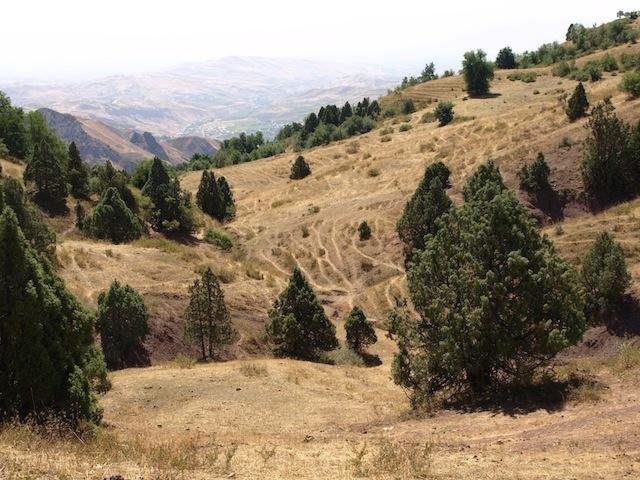
Sustainable managements on pasture and forest lands based … [ຕາຈິກິສະຕານ]
Sustainable managements on pasture and forest lands based on natural regeneration by electrified fences
- ຜູ້ສັງລວມຂໍ້ມູນ: Kakubari Yochitaka

Afforestation/Tree planting [ອູເຈນດາ]
Tree planting carried out by individual land users on hilly slopes to improve soil cover ,reduce wind strength , provide wood fuel & household income.
- ຜູ້ສັງລວມຂໍ້ມູນ: Wilson Bamwerinde
2. ການອະທິບາຍ ເຕັກໂນໂລຢີ ຂອງການຄຸ້ມຄອງ ທີ່ດິນແບບຍືນຍົງ
2.1 ຄໍາອະທິບາຍສັ້ນຂອງ ເຕັກໂນໂລຢີ
ການກຳໜົດຄວາມໝາຍ ຂອງເຕັກໂນໂລຢີ:
Afforestation is a key technologies to protect soil against erosion and provide a wide range of ecosystem services. In this case, afforestation at high altitudes, which is particularly challenging, with the primary purpose of erosion control were planted in small patches with different methods. They form the basis for future community forests in Armenia.
2.2 ການອະທິບາຍ ລາຍລະອຽດ ຂອງເຕັກໂນໂລຢີ
ການພັນລະນາ:
Forests are - in terms of biomass accumulation and stability - the most successful ecosystems in the world. Natural forest ecosystems offer multiple ecosystem services, such as timber and fuel wood provision, water purification, carbon sequestration. In mountainous landscapes, forests have an additional protective function against erosion and natural hazards (e.g., avalanches, landslides, debris flows or rock falls). In the South Caucasus, two natural limits restrict forest expansion: at 2.300-2.600m a.s.l. the upper tree line is visible, whereas steppe and semi-desert ecosystems form the lower tree line.
Socio-economic and geo-physical living conditions:
The intervention area is located at the northern to eastern slopes of Mount Aragats (4013m). The villages are located at 1600 to 1800 m above sea level where the slope meets a plain with stepic soils and crop production while the slopes of the mountains are used for livestock grazing (sheep and cattle).
Purpose of afforestation:
By means of afforestation of degraded pastures, mountainous areas that suffer from erosion and overgrazing should be rehabilitated and erosion protection capacity enhanced. At the same time, the afforestation sites should form the basis for future community forests providing a wide range of ecosystem services, a concept that has not yet been established in Armenia.
Implementation
Between 2014 and 2017 more than 200 hectares were fenced for afforestation, 145 ha were actively afforested in 10 different communities around Mount Aragats in Armenia. The average size of the 20 plots is 10 ha (35 ha being the largest site, 1 ha the smallest one).
The afforestation included different species combinations, planting schemes and methods to determine most cost-efficient afforestation methods for Armenian conditions. All afforestation took place at elevations between 1900 and 2300 m.a.s.l.. The afforestation included fencing of the area to protect the afforestation site against grazing, the preparation of the planting sites according to fixed planting schemes, the actual planting in lines with trenches, single plant holes and group plantings. For some sites, additional irrigation was established for the first years. Particular attention was paid to the species selection which explicitly included fruit trees and shrubs to ensure local economic returns.
Practical experiences
A wide range species was tested. Within the given climate context, pine (Pinus sylvestris), the main non-native species as well as native maple (Acer trautvetteri), Persian Oak (Quercus macranthera) and birch (Betula litwinowii) showed the best results. Particular attention was paid to adapted species to create resilient forest-shrubland with a large number of tree species. In general, planting in trenches shows highest survival rates. Bare root system and containerized seedlings were used for planting. Containerized seedlings definitely provide better survival rate in comparison with bare root system seedlings. Additionally, mulch cover was provided to protect seedlings and keep soil humidity. The main maintenance measures are repeated mulching and weed control and irrigation during the first 3 years. Furthermore, some replanting is continuously taking place as the sites are facing tough environmental conditions (hot summers, drought, short vegetation period).
The plantation was organised and supervised by local NGO's (ATP Armenian Tree Project, ESAC Environmental Sustainability Assistance Center) in close cooperation with the local village population. In a Memorandum of Understandig between the Armenian Ministry of Territorial Administration and Development, the local village administration and GIZ the share of payed labour and own contribution was fixed beforehand.
Impacts and perception
After the first years already first successes are becoming visible contributing to increased vegetation cover, increased biomass and improved soil protection. The communities are proud to be amongst the first in Armenia with a community forest. However, slow growth will require continuous commitment and care on behalf of the community.
2.3 ຮູບພາບຂອງເຕັກໂນໂລຢີ
2.4 ວິດີໂອ ເຕັກໂນໂລຢີ
ຄວາມຄິດເຫັນ, ຄໍາອະທິບາຍຫຍໍ້:
Short video of ESAC, the implementing NGO, on afforestation background and techniques
https://www.youtube.com/watch?v=cLZ5ucDDclI
ວັນທີ:
28/10/2018
ສະຖານທີ່:
Aragatsotn and Shirak Marzes
ຊື່ຂອງຜູ້ຖ່າຍວີດີໂອ:
ESAC NGO (Khachatur Khachtryan)
ຄວາມຄິດເຫັນ, ຄໍາອະທິບາຍຫຍໍ້:
Short video of ESAC, the implementing NGO on different fencing techniques used for protecting the afforestation sites
https://www.youtube.com/watch?v=INRnvnkYzCE
ວັນທີ:
28/03/2018
ສະຖານທີ່:
Aragatsotn and Shirak Marzes
ຊື່ຂອງຜູ້ຖ່າຍວີດີໂອ:
ESAC NGO (Khachatur Khachtryan)
2.5 ປະເທດ / ເຂດ / ສະຖານທີ່ບ່ອນທີ່ ເຕັກໂນໂລຢີ ໄດ້ຮັບການນໍາໃຊ້ ແລະ ທີ່ຖືກປົກຄຸມດ້ວຍການປະເມີນຜົນ
ປະເທດ:
ອໍເມເນຍ
ພາກພື້ນ / ລັດ / ແຂວງ:
Shirak and Aragatsotn Marzes
ຂໍ້ມູນເພີ່ມເຕີມຂອງສະຖານທີ່:
Lusagyugh, Saralanj, Harich, Arayi, Quchak, Hnaberd, Mets Manatash, Pokr Mantash, Nahapetavan
ຄວາມຄິດເຫັນ:
Differerent small afforestation plots between 1 and 30 ha with a total of approximately 200 ha
Map
×2.6 ວັນທີໃນການຈັດຕັ້ງປະຕິບັດ
ຖ້າຫາກວ່າ ບໍ່ຮູ້ຈັກ ປີທີ່ຊັດເຈນ ແມ່ນໃຫ້ປະມານ ວັນທີເອົາ:
- ຕໍ່າກວ່າ 10 ປີ ຜ່ານມາ (ມາເຖິງປະຈຸບັນ)
2.7 ການນໍາສະເໜີ ເຕັກໂນໂລຢີ
ໃຫ້ລະບຸ ເຕັກໂນໂລຢີ ໄດ້ຖືກຈັດຕັ້ງປະຕິບັດຄືແນວໃດ?
- ໂດຍຜ່ານໂຄງການ / ການຊ່ວຍເຫຼືອຈາກພາຍນອກ
ຄວາມຄິດເຫັນ (ປະເພດ ໂຄງການ ແລະ ອື່ນໆ):
This project introduced community-managed forests for erosion control to different communities. Different planting techniques and species were piloted to identify most appropriate afforestation and management methods.
3. ການໃຈ້ແຍກ ເຕັກໂນໂລຢີ ໃນການຄຸ້ມຄອງ ດິນແບບຍືນຍົງ
3.1 ຈຸດປະສົງຫຼັກ (ຫຼາຍ) ຂອງເຕັກໂນໂລຢີ
- ຫຼຸດຜ່ອນ, ປ້ອງກັນ, ຟື້ນຟູ ການເຊື່ອມໂຊມຂອງດິນ
- ການອະນຸລັກ ລະບົບນິເວດ
- ປົກປັກຮັກສາ / ການປັບປຸງຊີວະນາໆພັນ
- ຫຼຸດຜ່ອນຜົນກະທົບ ຈາກການປ່ຽນແປງດິນຟ້າອາກາດ
3.2 ປະເພດການນໍາໃຊ້ທີ່ດິນ ໃນປະຈຸບັນ() ທີ່ເຕັກໂນໂລຢີ ໄດ້ຖືກນໍາໃຊ້

ທົ່ງຫຍ້າລ້ຽງສັດ
ທົ່ງຫຍ້າລ້ຽງສັດທໍາມະຊາດ:
- ແບບເຄິ່ງຂັງ / ເຄິ່ງປ່ອຍ
ຊະນິດພັນສັດຕົ້ນຕໍ ແລະ ຜະລິດຕະພັນ:
Cattle and sheep

ປ່າໄມ້ / ປ່າ
ການປູກຕົ້ນໄມ້, ການປູກປ່າ:
- ແນວພັນປະສົມ
ຜົນຜະລິດ ແລະ ການບໍລິການ:
- ໄມ້ຟືນ
- ໝາກໄມ້ ແລະ ແກ່ນຖົ່ວ
- ທົ່ງຫຍ້າ
- ປ້ອງກັນ ການຄຸກຄາມ ທາງທໍາມະຊາດ
ຖ້າຫາກວ່າ ການນໍາໃຊ້ທີ່ດິນ ມີການປ່ຽນແປງ ໃນເວລາ ຈັດຕັ້ງປະຕິບັດ ເຕັກໂນໂລຢີ, ແມ່ນໃຫ້ລະບຸວ່າ ດິນພື້ນທີ່ດັ່ງກ່າວ ເຄີຍເປັນດິນປະເພດໃດ ກ່ອນການຈັດຕັ້ງປະຕິບັດ ເຕັກໂນໂລຢີ:
The afforestation sites were previously used as (partly overgrazed) pastures for grazing of mainly cattle. Thus, this technology included a land-use change from grassland/pasture to forest/shrubland.
3.3 ຂໍ້ມູນເພີ່ມເຕີມກ່ຽວກັບການນໍາໃຊ້ທີ່ດິນ
ການສະໜອງນໍ້າ ໃນພື້ນທີ່ ທີ່ໄດ້ນໍາໃຊ້ ເຕັກໂນໂລຢີ:
- ປະສົມປະສານ ກັນລະຫວ່າງ ນໍ້າຝົນ ແລະ ນໍ້າຊົນລະປະທານ
ຈໍານວນ ລະດູການ ປູກໃນປີໜຶ່ງ:
- 1
ຄວາມໜາແໜ້ນ ຂອງສັດລ້ຽງ (ຖ້າຫາກວ່າກ່ຽວຂ້ອງ):
1-2/ha
3.4 ການນໍາໃຊ້ເຕັກໂນໂລຢີ ທີ່ຢູ່ໃນກຸ່ມການຄຸ້ມຄອງ ທີ່ດິນແບບຍືນຍົງ
- ການຄຸ້ມຄອງ ຊັບພະຍາກອນ ປ່າໄມ້ ທຳມະຊາດ ແລະ ເຄີ່ງທຳມະຊາດ
- ການປິດພື້ນທີ່ (ຢຸດການນໍາໃຊ້, ເພື່ອປູກເປັນປ່າຟື້ນຟູ)
- ຫຼຸດຜ່ອນຄວາມສ່ຽງ ທາງໄພພິບັດ ບົນພື້ນຖານລະບົບນິເວດ
3.5 ການຂະຫຍາຍເຕັກໂນໂລຢີ
ໃຫ້ລະບຸ ການແຜ່ຂະຫຍາຍ ເຕັກໂນໂລຢີ:
- ແຜ່ຂະຫຍາຍຢ່າງໄວວາໃນພື້ນທີ່
ຖ້າຫາກວ່າ ເຕັກໂນໂລຢີ ໄດ້ແຜ່ຂະຫຍາຍທົ່ວພື້ນທີ່ືື ຢ່າງສະໜ່ຳສະເໝີ, ໃຫ້ລະບຸ ເນື້ອທີ່ ໂດຍການຄາດຄະເນ:
- < 0.1 ກິໂລແມັດ2 (10 ເຮັກຕາ)
ຄວາມຄິດເຫັນ:
Individual sites vary between 1 and 35 ha with a total area covered of 200 ha (2 km²) . However, it showed that communities only have the capacity to maintain a maximum size of 10 ha (maintenance). If managed by the community, it should not be larger.
3.6 ມາດຕະການ ການຄຸ້ມຄອງ ທີ່ດິນແບບຍືນຍົງ ປະກອບດ້ວຍ ເຕັກໂນໂລຢີ

ມາດຕະການ ທາງດ້ານພືດພັນ
- V1: ເປັນໄມ້ຢືນຕົ້ນ ແລະ ການປົກຫຸ້ມຂອງໄມ້ພຸ່ມ

ມາດຕະການ ທາງດ້ານການຄຸ້ມຄອງ
- M1: ການປ່ຽນແປງ ປະເພດ ການນໍາໃຊ້ທີ່ດິນ
3.7 ປະເພດດິນເຊື່ອມໂຊມ ຫຼັກທີ່ໄດ້ນໍາໃຊ້ ເຕັກໂນໂລຢີ

ດິນເຊາະເຈື່ອນ ໂດຍນໍ້າ
- Wt: ການສູນເສຍຊັ້ນໜ້າດິນ / ການເຊາະເຈື່ອນຜິວໜ້າດິນ
- Wg: ການເຊາະເຈື່ອນຮ່ອງນ້ຳ / ຫ້ວຍ

ການເຊື່ອມໂຊມ ທາງຊີວະພາບ
- Bc: ການຫຼຸດຜ່ອນການປົກຫຸ້ມຂອງພືດ
- Bs: ຄຸນນະພາບ / ການອັດແໜ້ນ ຂອງສາຍພັນຫຼຸດລົງ
3.8 ການປ້ອງກັນ, ການຫຼຸດຜ່ອນ, ຫຼືການຟື້ນຟູຂອງການເຊື່ອມໂຊມຂອງດິນ
ໃຫ້ລະບຸ ເປົ້າໝາຍ ເຕັກໂນໂລຢີ ທີ່ພົວພັນ ກັບຄວາມເຊື່ອມໂຊມຂອງດິນ:
- ປ້ອງກັນການເຊື່ອມໂຊມຂອງດິນ
- ຫຼຸດຜ່ອນການເຊື່ອມໂຊມຂອງດິນ
4. ຂໍ້ກໍາໜົດ, ກິດຈະກໍາການປະຕິບັດ, ວັດຖຸດິບ, ແລະຄ່າໃຊ້ຈ່າຍ
4.1 ເຕັກນິກ ໃນການແຕ້ມແຜນວາດ ເຕັກໂນໂລຢີ
4.2 ການແຕ້ມແຜນວາດອະທິບາຍເຕັກນິກ
Needed resources for 1 ha afforestation:
- 2.000-5.000 seedlings
- 10-50 t water (for initial irrigation)
- 40 – 100 working days
- Shuffles or soil driller
- Means of transport
Selection of species
It is recommended to use different local tree species for any afforestation activity, as they can cope best with the given environmental conditions and, therefore, are more resilient towards pests and climatic variations. Most suitable species for afforestation:
-Trautvetters maple (Acer trautvetteri)
-Birch (Betula letwinowii)
-Wild Oriental Apple (Malus orientalis)
-Scott’s Pine (Pinus sylvestris var. hamata)
-Persian Oak (Quercus macranthera)
-Raspberry (Rubus idaeus)
-Mountain ash (Sorbus aucuparia)
For selecting suitable species, screening of the wider project area is essential in order to prepare a list of species, which would naturally grow under the given ecological conditions
Planting scheme
The technical drawings describe different potential planting schemes. A further figure describes the advantages and disadvantages of each scheme.
Planting season
The climate in the South Caucasus region shows low precipitation rates in the summer period. As seedlings have a small root system, young trees are more sensitive to drought. The best time for planting is either autumn or early spring as during autumn, winter and spring, more moisture is available that helps the seedlings to develop deeper root systems to survive during summer droughts.
Fencing
In many cases, afforestation sites are located on pasture land. To protect the planted seedlings from browsing by livestock or wild game, it is recommended to fence the afforestation site before starting the plantation of the seedlings.
Planting
The planting process is specified in one of the technical drawings. With a hole driller planting of one tree takes 2-4 minutes, planting by hand 8-10 min. Each seedling is waterered with an intial 5-10 l of water.
4.3 ຂໍ້ມູນທົ່ວໄປກ່ຽວກັບການຄິດໄລ່ປັດໃຈຂາເຂົ້າໃນການຜະລິດ ແລະ ມູນຄ່າອື່ນໆ
ລະບຸ ວິທີການ ຄຳໃຊ້ຈ່າຍ ແລະ ປັດໄຈນໍາເຂົ້າ ທີ່ໄດ້ຄິດໄລ່:
- ຕໍ່ພື້ນທີ່ ທີ່ໄດ້ຈັດຕັ້ງປະຕິບັດ ເຕັກໂນໂລຢີ
ໃຫ້ລະບຸຫົວໜ່ວຍ ຂະໜາດ ແລະ ເນື້ອທີ່:
1 ha
ລະບຸ ສະກຸນເງິນທີ່ໃຊ້ສໍາລັບ ການຄິດໄລ່ຄ່າໃຊ້ຈ່າຍ:
- ໂດລາສະຫະລັດ
4.4 ການສ້າງຕັ້ງກິດຈະກໍາ
| ກິດຈະກໍາ | ປະເພດ ມາດຕະການ | ໄລຍະເວລາ | |
|---|---|---|---|
| 1. | Selection of afforestation site, plantation scheme and species | ການຈັດການຄຸ້ມຄອງ | anytime |
| 2. | Fencing of the area (if area is being grazed or wild game is browsing seedlings | ໂຄງສ້າງ | before planting |
| 3. | Prepare and transfer seedlings to the site | ການຈັດການຄຸ້ມຄອງ | before planting |
| 4. | Excavate whole for the seedling (30-40cm deep, 25 cm diameter, 1m spacing between wholes) | ໂຄງສ້າງ | autumn, early spring |
| 5. | Place the seedling and fill hole with soil | ການບໍາລຸງລ້ຽງ | autumn, early spring |
| 6. | Apply 5-10 l of water immediately after planting | ການຈັດການຄຸ້ມຄອງ | after planting |
| 7. | Cover soil around seedling with mulch and organic material | ການບໍາລຸງລ້ຽງ | after planting |
4.5 ຕົ້ນທຶນ ແລະ ປັດໄຈຂາເຂົ້າທີ່ຈໍາເປັນໃນຈັດຕັ້ງປະຕິບັດ
| ລະບຸ ປັດໃຈ ນໍາເຂົ້າ ໃນການຜະລີດ | ຫົວໜ່ວຍ | ປະລິມານ | ຕົ້ນທຶນ ຕໍ່ຫົວໜ່ວຍ | ຕົ້ນທຶນທັງໝົດ ຂອງປັດໃຈຂາເຂົ້າ ໃນການຜະລິດ | % ຂອງຕົ້ນທຶນທັງໝົດ ທີ່ຜູ້ນໍາໃຊ້ທີ່ດິນ ໃຊ້ຈ່າຍເອງ | |
|---|---|---|---|---|---|---|
| ແຮງງານ | Local workers for plantation of trees | seedlings | 2500.0 | 0.27 | 675.0 | 10.0 |
| ແຮງງານ | Installation of fence and posts | person day | 191.0 | 12.3 | 2349.3 | |
| ອຸປະກອນ | Equipment (hummer, driller, etc.) | set | 1.0 | 141.8 | 141.8 | 30.0 |
| ວັດສະດຸໃນການປູກ | Tree seedlings | pieces | 2500.0 | 0.31 | 775.0 | |
| ວັດສະດຸໃນການປູກ | Mulching | kg | 1250.0 | 0.03 | 37.5 | |
| ວັດສະດຸກໍ່ສ້າງ | Fencing (permanent mesh wire fence) | meter | 317.0 | 1.35 | 427.95 | 10.0 |
| ວັດສະດຸກໍ່ສ້າງ | Irrigation system | set | 1.0 | 889.0 | 889.0 | 15.0 |
| ວັດສະດຸກໍ່ສ້າງ | Metal posts for fence (1.8m) | pieces | 106.0 | 2.97 | 314.82 | |
| ວັດສະດຸກໍ່ສ້າງ | sand | kg | 3444.0 | 0.012 | 41.33 | |
| ວັດສະດຸກໍ່ສ້າງ | Other material(electrode, wire armature, metal disc) | set | 1.0 | 386.9 | 386.9 | 20.0 |
| ວັດສະດຸກໍ່ສ້າງ | Cement | kg | 1148.0 | 0.12 | 137.76 | |
| ອື່ນໆ | Transporation of mulch | time | 1.0 | 102.8 | 102.8 | |
| ອື່ນໆ | Transporation of construction materials | time | 5.0 | 92.5 | 462.5 | |
| ອື່ນໆ | Transporation of workers to the field | time | 15.0 | 30.2 | 453.0 | |
| ອື່ນໆ | Transporation of seedlings | time | 1.0 | 51.4 | 51.4 | |
| ຕົ້ນທຶນທັງໝົດ ໃນການຈັດຕັ້ງປະຕິບັດ ເຕັກໂນໂລຢີ | 7246.06 | |||||
ຖ້າຫາກຜູ້ນຳໃຊ້ທີ່ດິນ ນຳໃຊ້ມູນຄ່າຕ່ຳກວ່າ 100% ໃຫ້ລະບຸ ແມ່ນໃຜເປັນຜູ້ຊ່ວຍ ໃນລາຍຈ່າຍທີ່ເຫຼືອ:
GIZ Project
ຄວາມຄິດເຫັນ:
The above calculation is not made on purely 1 ha, since the project did not implement afforestation on 1 ha. This calculation was done on 2.6 ha, then the costs are proportionally distributed for 1 ha.
4.6 ບໍາລຸງຮັກສາ / ແຜນຈັດຕັ້ງປະຕິບັດ ກິດຈະກໍາ
| ກິດຈະກໍາ | ປະເພດ ມາດຕະການ | ໄລຍະເວລາ / ຄວາມຖີ່ | |
|---|---|---|---|
| 1. | Irrigation of young seedlings with 5-10 l | ການຈັດການຄຸ້ມຄອງ | 2-4 times per year for the first two years |
| 2. | Preparation of fire protection trenches | ໂຄງສ້າງ | if needed |
| 3. | Mowing to prevent overgrowth of seedlings | ການບໍາລຸງລ້ຽງ | 1-2 times per year |
| 4. | Renew mulch layer | ການຈັດການຄຸ້ມຄອງ | annually after hay harvest in summer |
| 5. | Replanting of seedlings (10% each year) | ການຈັດການຄຸ້ມຄອງ | annually to be done for the first 5 years |
4.7 ຄ່າໃຊ້ຈ່າຍ ແລະ ປັດໄຈນໍາເຂົ້າທີ່ຈໍາເປັນສໍາລັບການບໍາລຸງຮັກສາກິດຈະກໍາ / ແຜນປະຕິບັດ (ຕໍ່ປີ)
| ລະບຸ ປັດໃຈ ນໍາເຂົ້າ ໃນການຜະລີດ | ຫົວໜ່ວຍ | ປະລິມານ | ຕົ້ນທຶນ ຕໍ່ຫົວໜ່ວຍ | ຕົ້ນທຶນທັງໝົດ ຂອງປັດໃຈຂາເຂົ້າ ໃນການຜະລິດ | % ຂອງຕົ້ນທຶນທັງໝົດ ທີ່ຜູ້ນໍາໃຊ້ທີ່ດິນ ໃຊ້ຈ່າຍເອງ | |
|---|---|---|---|---|---|---|
| ແຮງງານ | Irrigation of young seedlings with 5-10 l | Man/day | 1.0 | 10.0 | 10.0 | 100.0 |
| ແຮງງານ | Preparation of fire protection trenches | rm | 150.0 | 0.34 | 51.0 | 100.0 |
| ແຮງງານ | Mowing to prevent overgrowth of seedlings | Man/day | 4.0 | 10.0 | 40.0 | 50.0 |
| ແຮງງານ | Renew mulch layer (including mulch value) | Man/day | 5.0 | 10.0 | 50.0 | 50.0 |
| ວັດສະດຸໃນການປູກ | Seedlings for replantation (including labour) | seedlings | 1200.0 | 0.51 | 612.0 | 50.0 |
| ອື່ນໆ | Petrol for irrigation | liter | 7.0 | 0.8 | 5.6 | |
| ຕົ້ນທຶນທັງໝົດ ທີ່ໃຊ້ໃນການບໍາລຸງຮັກສາ ເຕັກໂນໂລຢີ | 768.6 | |||||
ຖ້າຫາກຜູ້ນຳໃຊ້ທີ່ດິນ ນຳໃຊ້ມູນຄ່າຕ່ຳກວ່າ 100% ໃຫ້ລະບຸ ແມ່ນໃຜເປັນຜູ້ຊ່ວຍ ໃນລາຍຈ່າຍທີ່ເຫຼືອ:
GIZ project
ຄວາມຄິດເຫັນ:
The rather high costs are mostly linked to the permanent fence to protect seedlings against grazing and to high number of seedlings per hectare. In some parts initial irrigation was necessary due to dry summer conditions. Maintenance activities such as irrigation of seedlings in summer, anti-fire measures, replantation of seedlings (10 % each year for 5 years), mowing of grass and renewing of mulch layer are needed.
4.8 ປັດໄຈ ທີ່ສໍາຄັນ ທີ່ສົ່ງຜົນກະທົບ ຕໍ່ຄ່າໃຊ້ຈ່າຍ
ໃຫ້ອະທິບາຍ ປັດໃຈ ທີ່ສົ່ງຜົນກະທົບ ຕໍ່ຕົ້ນທຶນ ໃນການຈັດຕັ້ງປະຕິບັດ:
With costs of approximately 5,700 USD/ha including fencing (30%), planting (30%) and seedlings (40%) afforestation is very intensive in financial resources. It is very likely that these high costs will limit the upscaling of the afforestation process. There are some options to reduce costs:
•Fence large areas and try to have sites in square or circle shape
•Increase number of seedlings planted by person by using soil-drillers
•Use cheaper fencing material (e.g. game protection fence, poles without concrete)
•Reduce seedling number to 2000-3000 seedlings/ha
•Using seeds (e.g. oak) instead of seedlings
•Regrow seeds in local low-cost nurseries (e.g. Lusagyugh)
5. ສະພາບແວດລ້ອມທໍາມະຊາດ ແລະ ມະນຸດ
5.1 ອາກາດ
ປະລິມານນໍ້າຝົນປະຈໍາປີ
- < 250 ມີລິແມັດ
- 251-500 ມີລິແມັດ
- 501-750 ມີລິແມັດ
- 751-1,000 ມີລິແມັດ
- 1,001-1,500 ມີລິແມັດ
- 1,501-2,000 ມີລິແມັດ
- 2,001-3,000 ມີລິແມັດ
- 3,001-4,000 ມີລິແມັດ
- > 4,000 ມີລິແມັດ
ໃຫ້ລະບຸສະເລ່ຍ ປະລິມານນໍ້າຝົນຕົກປະຈໍາປີ ເປັນມິນລິແມັດ (ຖ້າຫາກຮູ້ຈັກ):
521.00
ຂໍ້ມູນສະເພາະ / ຄວາມເຫັນກ່ຽວກັບ ປະລິມານນໍ້າຝົນ:
Precipitation peak between May and June.
ໃຫ້ລະບຸ ຊື່ສະຖານີ ອຸຕຸນິຍົມ ເພື່ອເປັນຂໍ້ມູນອ້າງອີງ:
Aparan, Aragatsotn Marz, Armenia
ເຂດສະພາບອາກາດກະສິກໍາ
- ເຄິ່ງແຫ້ງແລ້ງ
According to Köppen and Geiger, the climate is classified as Dfb (Cold/continental, no dry season, warm summers). Annual mean temperature is 5.2. °C. The warmest month of the year is August, with an average temperature of 16.4 °C. January has the lowest average temperature of the year with -6.9 °C.
based on data from the following source: https://www.arcgis.com/home/webmap/viewer.html?layers=3ac478a468c245ef9bfd5533f7edbf93
5.2 ພູມິປະເທດ
ຄ່າສະເລ່ຍ ຄວາມຄ້ອຍຊັນ:
- ພື້ນທີ່ຮາບພຽງ (0-2%)
- ອ່ອນ (3-5 %)
- ປານກາງ (6-10 %)
- ມ້ວນ (11-15 %)
- ເນີນ(16-30%)
- ໍຊັນ (31-60%)
- ຊັນຫຼາຍ (>60%)
ຮູບແບບຂອງດິນ:
- ພູພຽງ / ທົ່ງພຽງ
- ສັນພູ
- ເປີ້ນພູ
- ເນີນພູ
- ຕີນພູ
- ຮ່ອມພູ
ເຂດລະດັບສູງ:
- 0-100 ແມັດ a.s.l.
- 101-500 ແມັດ a.s.l.
- 501-1,000 ແມັດ a.s.l.
- 1,001-1,500 ແມັດ a.s.l.
- 1,501-2,000 ແມັດ a.s.l.
- 2,001-2,500 ແມັດ a.s.l.
- 2,501-3,000 ແມັດ a.s.l.
- 3,001-4,000 ແມັດ a.s.l.
- > 4,000 ແມັດ a.s.l.
ໃຫ້ລະບຸ ເຕັກໂນໂລຢີ ທີ່ໄດ້ຖືກນຳໃຊ້:
- ບໍ່ກ່ຽວຂ້ອງ
5.3 ດິນ
ຄວາມເລິກ ຂອງດິນສະເລ່ຍ:
- ຕື້ນຫຼາຍ (0-20 ຊັງຕີແມັດ)
- ຕື້ນ (21-50 ຊຕມ)
- ເລີກປານກາງ (51-80 ຊຕມ)
- ເລິກ (81-120 ຊມ)
- ເລິກຫຼາຍ (> 120 cm)
ເນື້ອດິນ (ໜ້າດິນ):
- ປານກາງ (ດິນໜຽວ, ດິນໂຄນ)
ເນື້ອດິນ (ເລິກຈາກໜ້າດິນ ລົງໄປຫຼາຍກວ່າ 20 ຊັງຕິແມັດ):
- ປານກາງ (ດິນໜຽວ, ດິນໂຄນ)
ຊັ້ນອິນຊີວັດຖຸ ເທິງໜ້າດິນ:
- ປານກາງ (1-3 %)
5.4 ມີນໍ້າ ແລະ ຄຸນນະພາບ
ລະດັບ ນໍ້າໃຕ້ດິນ:
5-50 ແມັດ
ການມີນໍ້າ ເທິງໜ້າດິນ:
ປານກາງ
ຄຸນນະພາບນໍ້າ (ບໍ່ມີການບໍາບັດ):
ບໍ່ມີນໍ້າດື່ມ (ຮຽກຮ້ອງໃຫ້ມີການບຳບັດນ້ຳ)
ມີບັນຫາ ກ່ຽວກັບນໍ້າເຄັມບໍ່?
ບໍ່ແມ່ນ
ເກີດມີນໍ້າຖ້ວມ ໃນພື້ນທີ່ບໍ່?
ບໍ່ແມ່ນ
5.5 ຊີວະນາໆພັນ
ຄວາມຫຼາກຫຼາຍ ທາງສາຍພັນ:
- ປານກາງ
ຄວາມຫຼາກຫຼາຍ ທາງດ້ານ ທີ່ຢູ່ອາໃສ ຂອງສິ່ງທີ່ມີຊີວິດ:
- ຕໍ່າ
5.6 ຄຸນລັກສະນະ ຂອງຜູ້ນໍາໃຊ້ທີ່ດິນ ທີ່ໄດ້ນໍາໃຊ້ເຕັກໂນໂລຢີ
ຢູ່ປະຈຳ ຫຼື ເຄື່ອນຍ້າຍຕະຫຼອດ:
- ບໍ່ເຄື່ອນໄຫວ
ລະບົບ ການຕະຫຼາດ ແລະ ຜົນຜະລິດ:
- ປະສົມ (ກຸ້ມຕົນເອງ / ເປັນສິນຄ້າ
ລາຍຮັບ ທີ່ບໍ່ໄດ້ມາຈາກ ການຜະລິດ ກະສິກໍາ:
- 10-50 % ຂອງລາຍຮັບທັງໝົດ
ລະດັບຄວາມຮັ່ງມີ:
- ທຸກຍາກ
- ສະເລ່ຍ
ບຸກຄົນ ຫຼື ກຸ່ມ:
- ກຸ່ມ / ຊຸມຊົນ
- ການຮ່ວມມື
ລະດັບ ການຫັນເປັນກົນຈັກ:
- ການໃຊ້ແຮງງານຄົນ
- ເຄື່ອງກົນຈັກ
ເພດ:
- ຜູ້ຍິງ
- ຜູ້ຊາຍ
ອາຍຸ ຂອງຜູ້ນໍາໃຊ້ທີ່ດິນ:
- ໄວກາງຄົນ
- ຜູ້ສູງອາຍຸ
5.7 ພື້ນທີ່ສະເລ່ຍຂອງທີ່ດິນ ຫຼື ເຊົ່າໂດຍຜູ້ໃຊ້ທີ່ດິນການນໍາໃຊ້ ເຕັກໂນໂລຢີ
- <0.5 ເຮັກຕາ
- 0.5-1 ເຮັກຕາ
- 1-2 ເຮັກຕາ
- 2-5 ເຮັກຕາ
- 5-15 ເຮັກຕາ
- 15-50 ເຮັກຕາ
- 50-100 ເຮັກຕາ
- 100-500 ເຮັກຕາ
- 500-1,000 ເຮັກຕາ
- 1,000-10,000 ເຮັກຕາ
- > 10,000 ເຮັກຕາ
ຖືໄດ້ວ່າ ເປັນຂະໜາດນ້ອຍ, ກາງ ຫຼື ໃຫຍ່ (ອີງຕາມເງື່ອນໄຂ ສະພາບຄວາມເປັນຈິງ ຂອງທ້ອງຖີ່ນ)? :
- ຂະໜາດນ້ອຍ
5.8 ເຈົ້າຂອງທີ່ດິນ, ສິດໃຊ້ທີ່ດິນ, ແລະ ສິດທິການນໍາໃຊ້ນໍ້າ
ເຈົ້າຂອງດິນ:
- ຊຸມຊົນ / ບ້ານ
ສິດທິ ໃນການນໍາໃຊ້ທີ່ດິນ:
- ຊຸມຊົນ (ທີ່ມີການຈັດຕັ້ງ)
ສິດທິ ໃນການນໍາໃຊ້ນໍ້າ:
- ຊຸມຊົນ (ທີ່ມີການຈັດຕັ້ງ)
5.9 ການເຂົ້າເຖິງການບໍລິການ ແລະ ພື້ນຖານໂຄງລ່າງ
ສຸຂະພາບ:
- ທຸກຍາກ
- ປານກາງ
- ດີ
ການສຶກສາ:
- ທຸກຍາກ
- ປານກາງ
- ດີ
ການຊ່ວຍເຫຼືອ ດ້ານວິຊາການ:
- ທຸກຍາກ
- ປານກາງ
- ດີ
ການຈ້າງງານ (ຕົວຢ່າງ, ການເຮັດກິດຈະກໍາອື່ນ ທີ່ບໍ່ແມ່ນ ການຜະລິດກະສິກໍາ):
- ທຸກຍາກ
- ປານກາງ
- ດີ
ຕະຫຼາດ:
- ທຸກຍາກ
- ປານກາງ
- ດີ
ພະລັງງານ:
- ທຸກຍາກ
- ປານກາງ
- ດີ
ຖະໜົນຫົນທາງ ແລະ ການຂົນສົ່ງ:
- ທຸກຍາກ
- ປານກາງ
- ດີ
ການດື່ມນໍ້າ ແລະ ສຸຂາພິບານ:
- ທຸກຍາກ
- ປານກາງ
- ດີ
ການບໍລິການ ທາງດ້ານການເງິນ:
- ທຸກຍາກ
- ປານກາງ
- ດີ
6. ຜົນກະທົບ ແລະ ລາຍງານສະຫຼຸບ
6.1 ການສະແດງຜົນກະທົບ ພາຍໃນພື້ນທີ່ ທີ່ໄດ້ຈັດຕັ້ງປະຕິບັດ ເຕັກໂນໂລຢີ
ຜົນກະທົບທາງເສດຖະກິດສັງຄົມ
ການຜະລິດ
ການຜະລິດອາຫານສັດ
ຄວາມຄິດເຫັນ / ລະບຸແຈ້ງ:
Within the fenced afforestation site, the grass could be cut and used as hay. The protection from grazing helps biomass development which leads to better protection from Surface water Erosion and this lead to soil-regeneration and increase of productivity.
ປ່າໄມ້ / ຄຸນນະພາບປ່າໄມ້
ຄວາມຄິດເຫັນ / ລະບຸແຈ້ງ:
The natural forest was removed for the purpose of grazing and the forest cover will be now re-established on the afforestation sites.
ປ່າຜະລິດ
ຄວາມຄິດເຫັນ / ລະບຸແຈ້ງ:
We mixed shrub species like raspberries and fruit-trees (wilde plumb) between the main tree species to create short time Benefit for the village people.
ຄວາມໜາແໜ້ນ ຂອງຜົນຜະລິດ
ຄວາມຄິດເຫັນ / ລະບຸແຈ້ງ:
In addition to the wide spread grazing land use now the hay production in the fenced afforestation site is increased for the first 1-2 decades (until the canopy is too dense) and the collection of berries and fruits give additional income opportunities. In the Long terme fuel wood production can be expected from the forested land.
ເນື້ອທີ່ການຜະລິດ
ຄວາມຄິດເຫັນ / ລະບຸແຈ້ງ:
The grazing range is limited by the fenced afforestation site. This is relevant in the first couple of years before hay or fruit/berry productivity is able to fully compensate the loss of grazing range.
ລາຍໄດ້ ແລະ ຄ່າໃຊ້ຈ່າຍ
ມີວຽກໜັກ
ຄວາມຄິດເຫັນ / ລະບຸແຈ້ງ:
The maintenance of the afforestation site lead to increase of workload especially in the first 2-4 years when hay cutting and Irrigation is needed until the tree seedlings are well established.
ຜົນກະທົບດ້ານວັດທະນາທໍາສັງຄົມ
ໂອກາດ ໃນການພັກຜ່ອນຢ່ອນໃຈ
ຄວາມຄິດເຫັນ / ລະບຸແຈ້ງ:
As there is almost no forest near to the villages every woodland is very attractive for recreational purpose, but it will Need 2-3 decades until this function will be fulfilled by the afforestation site.
ຄວາມຮູ້ກ່ຽວກັບ ການຄຸ້ມຄອງ ທີ່ດິນແບບຍືນຍົງ / ການເຊື່ອມໂຊມຂອງດິນ
ຄວາມຄິດເຫັນ / ລະບຸແຈ້ງ:
The local stakeholders got hands on training on fencing, afforestation and maintenance of afforestation sites.
ຜົນກະທົບຕໍ່ລະບົບນິເວດ
ວົງຈອນນໍ້າ / ນໍ້າ
ການໄຫຼ ຂອງນໍ້າໜ້າດິນ
ຄວາມຄິດເຫັນ / ລະບຸແຈ້ງ:
The fencing of the afforestation site immediately stops the heavy grazing Impact which leads to fast recovery of the Vegetation. The improved Vegetation cover and better development of the root System reduce Surface water run of Speed and increase water Infiltration.
ການລະເຫີຍອາຍ
ຄວາມຄິດເຫັນ / ລະບຸແຈ້ງ:
An increase of vegetation and the leaf area index will lead to an increase of evaporation.
ດິນ
ການສູນເສຍດິນ
ຄວາມຄິດເຫັນ / ລະບຸແຈ້ງ:
Increase of vegetation cover and reduction of water runoff will lead to decrease of soil loss.
ອິນຊີວັດຖຸໃນດິນ / ຢູ່ລຸ່ມຊັ້ນດິນ C
ຄວາມຄິດເຫັນ / ລະບຸແຈ້ງ:
The increase of vegetation leads to an increase of root development. Additionally, the increase of vegetation produces more litter, as no grazing is applied. The increase in litter leads to an increase of an humus layer and therefore to more below ground carbon.
ຊີວະນານາພັນ: ສັດ, ພືດ
ການປົກຫຸ້ມຂອງພືດ
ຄວາມຄິດເຫັນ / ລະບຸແຈ້ງ:
Especially the fencing leads to fast increase of vegetation cover.
ມວນຊີວະພາບ / ຢູ່ເທິງຊັ້ນດິນ C
ຄວາມຄິດເຫັນ / ລະບຸແຈ້ງ:
The local stakeholders got hands on training on fencing, afforestation and maintenance of afforestation sites.
ຄວາມຫຼາກຫຼາຍຂອງພືດ
ຄວາມຄິດເຫັນ / ລະບຸແຈ້ງ:
The stop of grazing and the new micro-habitats created by the shadow of the tree seedlings have let to an increase in plant diversity. This process might be reverse when the tree canopy is closed and less light is available for the herb-layer, but this will take several decades.
ຄວາມຫຼາກຫຼາຍ ທາງດ້ານທີ່ຢູ່ອາໃສ ຂອງສິ່ງທີ່ມີຊີວິດ
ຄວາມຄິດເຫັນ / ລະບຸແຈ້ງ:
The plain grasslands habitats are diversified by patches of forest.
6.2 ຜົນກະທົບທາງອ້ອມ ຈາກການນໍາໃຊ້ເຕັກໂນໂລຢີ
ການປ້ອງກັນ / ຄວາມອາດສາມາດ ການກັ່ນຕອງ
ຄວາມຄິດເຫັນ / ລະບຸແຈ້ງ:
The decrease of water run off increase the water capacity of the habitat and the afforested area will provide increase buffer capacity in the case of intensive rainfalls.
ລົມ ທີ່ພັດເອົາຕະກອນ
ຄວາມຄິດເຫັນ / ລະບຸແຈ້ງ:
The high grass and trees reduce wind speed at ground level.
ຄໍາເຫັນກ່ຽວກັບ ການປະເມີນ ຜົນກະທົບ:
Most of the afforestation sites are locate uphill of villages. Village people are expecting protection from cold down-hill winds from the mountain and an increase of air-moisture by the evapo-transpiration of the forest.
6.3 ການປ້ອງກັນ ແລະ ຄວາມບອບບາງ ຂອງເຕັກໂນໂລຢິ ໃນການປ່ຽນແປງສະພາບດິນຟ້າອາກາດ ແລະ ກ່ຽວຂ້ອງກັບອາກາດທີ່ມີການປ່ຽນແປງທີ່ຮຸນແຮງ / ໄພພິບັດທາງທໍາມະຊາດ (ຮັບຮູ້ໄດ້ໂດຍຜູ້ນໍາໃຊ້ທີ່ດິນ)
ອາກາດ ທີ່ກ່ຽວພັນກັບຄວາມຮຸນແຮງ (ໄພພິບັດທາງທໍາມະຊາດ)
ໄພພິບັດທາງອຸຕຸນິຍົມ
| ການນໍາໃຊ້ ເຕັກໂນໂລຢີ ສາມາດ ຮັບມື ໄດ້ຄືແນວໃດ? | |
|---|---|
| ພາຍຸເມກທ້ອງຖິ່ນ | ປານກາງ |
| ພາຍຸລູກເຫັບທ້ອງຖິ່ນ | ປານກາງ |
| ພາຍຸຫິມະໃນທ້ອງຖິ່ນ | ດີ |
ໄພພິບັດທາງຊີວະພາບ
| ການນໍາໃຊ້ ເຕັກໂນໂລຢີ ສາມາດ ຮັບມື ໄດ້ຄືແນວໃດ? | |
|---|---|
| ແມງໄມ້ / ການລະບາດຂອງພະຍາດ | ປານກາງ |
ຜົນສະທ້ອນສະພາບອາກາດອື່ນໆທີ່ກ່ຽວຂ້ອງ
ຜົນສະທ້ອນສະພາບອາກາດອື່ນໆທີ່ກ່ຽວຂ້ອງ
| ການນໍາໃຊ້ ເຕັກໂນໂລຢີ ສາມາດ ຮັບມື ໄດ້ຄືແນວໃດ? | |
|---|---|
| ໄລຍະເວລາການເຕີບໃຫຍ່ຂະຫຍາຍຕົວ | ດີ |
6.4 ການວິເຄາະຕົ້ນທຶນ ແລະ ຜົນປະໂຫຍດ
ຈະເຮັດປະໂຫຍດເພື່ອປຽບທຽບກັບຄ່າໃຊ້ຈ່າຍກັບສິ່ງກໍ່ສ້າງ (ຈາກທັດສະນະຂອງຜູ້ນຳໃຊ້ທີ່ດິນ) ໄດ້ແນວໃດ?
ຜົນຕອບແທນ ໃນໄລຍະສັ້ນ:
ຜົນກະທົບທາງລົບ
ຜົນຕອບແທນ ໃນໄລຍະຍາວ:
ຜົນກະທົບທາງບວກເລັກນ້ອຍ
ຈະໄດ້ຮັບຜົນປະໂຫຍດເມື່ອປຽບທຽບກັບ / ຄ່າໃຊ້ຈ່າຍໃນການບຳລຸງຮັກສາທີເ່ກີດຂື້ນອິກ (ຈາກທັດສະນະຄະຕິຂອງຜູ້ນຳໃຊ້ທີ່ດິນ) ໄດ້ແນວໃດ?
ຜົນຕອບແທນ ໃນໄລຍະສັ້ນ:
ຜົນກະທົບທາງລົບເລັກນ້ອຍ
ຜົນຕອບແທນ ໃນໄລຍະຍາວ:
ຜົນກະທົບທາງບວກ
ຄວາມຄິດເຫັນ:
In the first decade the efforts on maintenance are high and it can be expected that the return of natural resources (hay, berries, fruits) is significantly lower the the maintenance efforts. As soon the trees are established and larger than 1.3 the root system is well establish and the trees are resistant to droughts, no vegetation cutting is needed and even game or cattle browsing will not necessarily lead to lethal damage.
6.5 ການປັບຕົວຮັບເອົາເຕັກໂນໂລຢີ
- ກໍລະນີດຽວ / ການທົດລອງ
ທັງໝົດນັ້ນ ແມ່ນໃຜ ທີ່ເປັນຜູ້ປັບຕົວ ໃນການນໍາໃຊ້ ເຕັກໂນໂລຢີ, ມີຈັກຄົນ ທີ່ສາມາດເຮັດເອງໄດ້, ຕົວຢ່າງ, ປາດສະຈາກ ການຊ່ວຍເຫຼືອ ທາງດ້ານອຸປະກອນ / ການຈ່າຍເປັນເງິນ?
- 0-10%
6.6 ການປັບຕົວ
ໄດ້ມີການດັດປັບ ເຕັກໂນໂລຢີ ເພື່ອໃຫ້ແທດເໝາະກັບເງື່ອນໄຂ ການປ່ຽນແປງບໍ?
ແມ່ນ
ຖ້າແມ່ນ, ລະບຸແມ່ນເງື່ອນໄຂ ໃດທີ່ໄດ້ປ່ຽນແປງ ທີ່ເຮັດໃຫ້ເກີດມີການປັບຕົວ:
- ການປ່ຽນແປງດິນຟ້າອາກາດ / ຮ້າຍແຮງ
ລະບຸການຮັບຮອງເອົາ ເຕັກໂນໂລຢີ (ການອອກແບບ, ອຸປະກອນການ / ຊະນິດພັນ ແລະ ອື່ນໆ):
drought-adapted species, adaptation of planting schemes
6.7 ຈຸດແຂງ / ຂໍ້ດີ / ໂອກາດ ໃນການນໍາໃຊ້ ເຕັກໂນໂລຢີ
| ຈຸດແຂງ / ຂໍ້ດີ / ໂອກາດໃນການນໍາໃຊ້ທີ່ດິນ |
|---|
| Extension of forest cover of communities, new habitat for wild creators, forest will be a fire wood and non timber products source for local inhabitants, attraction of tourists into the communities, increased water regulating function, improved soil quality, increased vegetation, microclimate formation function, wind velocity reduction, reduced land degradation, nice view of the area due to afforestation,increased fodder for cattle |
| empowerment of the local capacities on sustainable land management |
| successful demonstration of erosion control measures |
| ຈຸດແຂງ / ຈຸດດີ / ໂອກາດ ຈາກທັດສະນະຂອງຜູ້ປ້ອນຂໍ້ມູນ ຫຼື ບຸກຄົນສຳຄັນ |
|---|
| Diversification of land use options for local stakeholders. Future options for sustainable firewood supply, non-timber forests products (berries) and recreation |
| Option to use grass from cutting in between as fodder/hay production |
| side-effect of fencing is increase in biodiversity of grassland species due to exclusion from grazing. |
6.8 ຈຸດອ່ອນ / ຂໍ້ເສຍ / ຄວາມສ່ຽງ ໃນການນໍາໃຊ້ ເຕັກໂນໂລຢີ ແລະ ວິທີການແກ້ໄຂບັນຫາ
| ຈຸດອ່ອນ / ຂໍ້ເສຍ / ຄວາມສ່ຽງໃນມຸມມອງຂອງຜູ້ນໍາໃຊ້ທີ່ດິນ | ມີວິທີການແກ້ໄຂຄືແນວໃດ? |
|---|---|
| Reduces pasture land of community, which was converted into a forest | Villagers/farmers need to increase the amount of hay from their homestead gardens using irrigation |
| ຈຸດອ່ອນ/ຂໍ້ບົກຜ່ອງ/ຄວາມສ່ຽງ ຈາກທັດສະນະຂອງຜູ້ປ້ອນຂໍ້ມູນ ຫຼື ບຸກຄົນສຳຄັນ | ມີວິທີການແກ້ໄຂຄືແນວໃດ? |
|---|---|
| strong need for care taking in the first years | community commitment, strong ownership |
| Expensive due to high costs for fencing | Consider alternative, cheaper fencing methods (e.g. wildlife protection fence) |
| Complicated decision making processes by the project | More mandate given to the implementing NGOs |
7. ເອກະສານອ້າງອີງ ແລະ ການເຊື່ອມຕໍ່
7.1 ວິທີການ / ແຫຼ່ງຂໍ້ມູນ
- ການໄປຢ້ຽມຢາມພາກສະໜາມ, ການສໍາຫຼວດພາກສະໜາມ
- ການສໍາພາດ ຜູ້ນໍາໃຊ້ທີ່ດິນ
- ສໍາພາດ ຊ່ຽວຊານ ການຄຸ້ມຄອງ ດິນແບບຍືນຍົງ
2 international (Huber, Kirchmeir)
national?
- ການລວບລວມ ບົດລາຍງານ ແລະ ເອກະສານ ອື່ນໆ ທີ່ມີຢູ່ແລ້ວ
Information extracted from different project reports and submitted financial statements from implementation
7.2 ເອກກະສານອ້າງອີງທີ່ເປັນບົດລາຍງານ
ຫົວຂໍ້, ຜູ້ຂຽນ, ປີ, ISBN:
Handbook on Integrated Erosion Control A Practical Guide for Planning and Implementing Integrated Erosion Control Measures in Armenia, GIZ (ed.), 2018, ISBN 978-9939-1-0721-9
ມີຢູ່ໃສ?ມູນຄ່າເທົ່າໃດ?
GIZ Armenia
7.3 ສາມາດເຊື່ອມໂຍງ ຂໍ້ມູນຂ່າວສານ ໄດ້ໂດຍຜ່ານການອອນລາຍ
ຫົວຂໍ້ / ພັນລະນາ:
Project website of the GIZ program
URL:
http://biodivers-southcaucasus.org/
ຂໍ້ມູນການເຊື່ອມຕໍ່ ແລະ ເນື້ອໃນ
ຂະຫຍາຍທັງໝົດ ຍຸບທັງໝົດການເຊື່ອມຕໍ່

Sustainable managements on pasture and forest lands based … [ຕາຈິກິສະຕານ]
Sustainable managements on pasture and forest lands based on natural regeneration by electrified fences
- ຜູ້ສັງລວມຂໍ້ມູນ: Kakubari Yochitaka

Afforestation/Tree planting [ອູເຈນດາ]
Tree planting carried out by individual land users on hilly slopes to improve soil cover ,reduce wind strength , provide wood fuel & household income.
- ຜູ້ສັງລວມຂໍ້ມູນ: Wilson Bamwerinde
ເນື້ອໃນ
ບໍ່ມີເນື້ອໃນ


